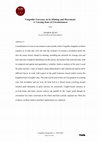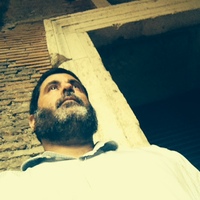Books by Andrew Kurt

Amsterdam University Press, 2020
This study of the Visigothic kingdom's monetary system in southern Gaul and Hispania from the fif... more This study of the Visigothic kingdom's monetary system in southern Gaul and Hispania from the fifth century through the Muslim invasion of Spain fills a major gap in the scholarship of late antiquity. Examining all aspects of the making of currency, it sets minting in relation to questions of state - monarchical power, administration and apparatus, motives for money production - and economy. In the context of the later Roman Empire and its successor states in the West, the minting and currency of the Visigoths reveal shared patterns as well as originality. The analysis brings both economic life and the needs of the state into sharper focus, with significant implications for the study of an essential element in daily life and government. This study combines an appreciation for the surprising level of sophistication in the Visigothic minting system with an accessible approach to a subject which can seem complex and abstruse.
Articles - Medieval History by Andrew Kurt
Visigothic Symposium 3, 2020
This Visigothic Symposium manages, by way of the selected themes and the variety of backgrounds o... more This Visigothic Symposium manages, by way of the selected themes and the variety of backgrounds of the authors, to illuminate a few similar subject areas treated with different shades of light. My comments will at first address some points among the first two papers on religious matters where I see commonality, then for the remaining papers

Visigothic Symposium 3, 2019
Consideration of coins in movement in and outside of the Visigothic kingdom in Iberia requires us... more Consideration of coins in movement in and outside of the Visigothic kingdom in Iberia requires us to take into view not only the evidence of currency circulation itself, but also the many factors related to minting, including the rationale for issuing coin and how and why it might be distributed. In this article, the layout of the mint network, with its temporal and spatial and quantitative variables, leads to analysis of the state's need for gold currency. Lines of inquiry along administrative and commercial aspects show different forces at work with respect to the gold tremisses issued widely across the kingdom from Liuvigild's day. The state can be seen to have its own purpose in creating coin, but circulation and use were far from tied to a closed circuit revolving around taxation paid ultimately in gold currency by aristocrats. Copper-based currency in several forms and from various sources ran parallel to the 'regal' gold, though its circulation was more restricted on the whole and had a mostly separate use. Here the evidence on these matters and their implications are explored.

Journal of Medieval Iberian Studies, 2015
While it is appropriate to remember that clerical and monastic elites form part of the whole whic... more While it is appropriate to remember that clerical and monastic elites form part of the whole which practices popular religion, it is clear that their spiritual habits were different from the rest of society. If ordinary Christians' piety was less intense, less educated, and less documented than that of religious elites, it does not mean we should neglect this aspect of daily life. The leading bishops in post-imperial Iberia exhibited a clear concern to shape the laity's piety not only in terms of orthodoxy but also in vibrancy. Liturgical texts and related writings from the Visigothic and early Mozarabic periods, including hagiographic material, provide a view of religious practices of the masses and ways in which the episcopate endeavored to direct devotion. Taken together the evidence suggests a surprising range and depth of lay religious experience, notwithstanding the errors of common Christians frequently suggested in ecclesiastical texts.
Journal of Medieval History 39.3 (Sept 2013), 297-320
In Brian Catlos, ed., A World of Economics and History: Essays in Honor of Professor Andrew M. Watson (Valencia: University of Valencia Press), 33-54
Numisma 241 (1998), 27-39
The article demonstrates the identity of a previously unknown Visigothic mint in southeastern Spa... more The article demonstrates the identity of a previously unknown Visigothic mint in southeastern Spain, where no mint was thought to have existed, and offers an explanation for this location by its probable connection with minting in the south-central area of the kingdom.
Reviews & entries - medieval/early modern/modern by Andrew Kurt
Oxford African American Studies Center, www.oxfordaasc.com, Oxford University Press, 2022, 2022
According to biographical notes in his own work, Ibn Iyas was of the fourth generation in a famil... more According to biographical notes in his own work, Ibn Iyas was of the fourth generation in a family of Mamluk soldiers, and his father was among the elite class (awlad al-nas, "sons of the people," or Mamluks' sons), though he was by a third-generation rule not allowed to serve militarily. Ibn Iyas thus

Oxford African American Studies Center, www.oxfordaasc.com, Oxford University Press, 2022, 2022
known by the prefix "Pargali," served as the grand vizier of Suleiman the Magnificent, sultan of ... more known by the prefix "Pargali," served as the grand vizier of Suleiman the Magnificent, sultan of the Ottoman empire (r. 1520-1566), from 1523 until his death. In 1525 he invaded Egypt to restore order on behalf of Suleiman following a rebellion there and left in place a detailed set of laws and an organization which shaped the province for many decades. The threat posed by his successes in the service of Suleiman, combined with one or another possible intrigue at court and apparently his own hubris, led to his sudden execution at the sultan's order when in his early forties. Ibrahim was a Christian from Parga (northwestern Greece) enslaved as a boy through the devshirme system. Early in his service he became a favorite and confidant of the young Suleiman and was elevated to the highest posts in the latter's palace and then in his government, first while Suleiman was prince of Magnesia (western Anatolia in present-day Turkey) and then when he became sultan. Ibrahim Pasha's
In Cenak Çakmak, ed., Islam: A Worldwide Encyclopedia (ABC-CLIO, 2017), 170-72, 2017
The International Encyclopedia of Revolution and Protest: 1500 to the Present (Malden, MA: Blackwell Publishing, 2009), 2406-08, Apr 20, 2009, 2009
Anyone who has translated at some length knows the difficulties of transmitting the original mean... more Anyone who has translated at some length knows the difficulties of transmitting the original meaning and that explanations are often necessary. A written translation of a major work, moreover, requires decisions on how it should be presented to suit the purpose of the translation. Many of the considerations that go into a translation today were faced by pre-modern translators, and in the case of rendering the Qur'an into Latin for readers in western Europe the task was charged with religious tension. Reading the Qur'an in Latin Christendom is a meticulous study of the four pre-print Latin translations of the Qur'an and of their manuscript heritage.
In Cultural Sociology of the Middle East, Asia, and Africa: an Encyclopedia, v. 2, ed. Edward R... more In Cultural Sociology of the Middle East, Asia, and Africa: an Encyclopedia, v. 2, ed. Edward Ramsamy (Thousand Oaks, CA: SAGE Reference, 2012)
In Cultural Sociology of the Middle East, Asia, and Africa: an Encyclopedia, v. 2, ed. Edward R... more In Cultural Sociology of the Middle East, Asia, and Africa: an Encyclopedia, v. 2, ed. Edward Ramsamy (Thousand Oaks, CA: SAGE Reference, 2012)
In Cultural Sociology of the Middle East, Asia, and Africa: an Encyclopedia, v. 2, ed. Edward Ram... more In Cultural Sociology of the Middle East, Asia, and Africa: an Encyclopedia, v. 2, ed. Edward Ramsamy (Thousand Oaks, CA: SAGE Reference, 2012)
Articles & reviews - modern Afghanistan by Andrew Kurt
Digest of Middle East Studies 19.2 (Fall 2010), 213-27
Digest of Middle East Studies 22.1 (Spring 2013), 209-13
CfPs by Andrew Kurt

Networks and Neighbours
Networks and Neighbours (N&N) is thrilled to be organizing this international numismatics colloqu... more Networks and Neighbours (N&N) is thrilled to be organizing this international numismatics colloquium at the American Numismatic Society (ANS) in New York City.
This colloquium gathers scholars to NYC to work together for a few days with the renowned ANS collection and address questions relating to the currency. Speakers and guests will consider problems of materiality, identity, images and art, economy, minting, metallurgy and mining, as well as pertinent political, religious and cultural matters of Iberia and the broader Mediterranean economy in the Visigothic period.
The ANS collection of Visigothic coins is the largest in the world, comprised of over 900 imitative, pseudo-imperial and Visigothic gold pieces. It includes specimens of all the major kings of the early medieval kingdom and one usurper (Iudila) and represents a great number of the nearly one hundred mint sites in Iberia. A couple hundred of the coins can be traced back to nineteenth-century collectors such as Rafael Cervera and Luiz José Ferreira, and many of Cervera's coins can be traced to the exceptional seventh-century hoard of La Capilla near Seville.
In this colloquium, we will engage a range of artifacts and research methods over the course of a keynote and four plenary seminars, each with a presenter and a discussant. The keynote will prompt questions and encourage debate about methodological and historiographical issues related to the research and history of early medieval coins from around the Mediterranean. The rest of the colloquium will be divided according to complementing topics: the Visigothic coin collection and the historical, archaeological, archival and other issues involved in interpreting, narrating, uncovering and preserving the collection; issues of economy, circulation and identity in the Iberian Peninsula during the Visigothic period; and, the wider early medieval economy of the Mediterranean.
The program for the colloquium is nearly full, but we warmly invite students, scholars and others interested in the topic to attend. To register your interest in participating, please write to us at: networksandneighbours@gmail.com.
For more information, please see the colloquium website www.visigothiccoins.org, the N&N website, or email us.
As with all N&N events, this colloquium is entirely fees-free and open to anyone, and all pertinent costs for speakers are covered. The event will be [vegetarian] catered and followed by a formal dinner.
N&N would like to thank The Gladys Krieble Delmas Foundation for their generous support of this colloquium and its research.
Symposia, Workshops, Conferences by Andrew Kurt
Networks and Neighbours, 2019
Program: Coinage and Economy of the Early Medieval Mediterranean: A Colloquium @ American Numisma... more Program: Coinage and Economy of the Early Medieval Mediterranean: A Colloquium @ American Numismatic Society, 26-27 September 2019
Visigothic Symposia by Andrew Kurt
Visigothic Symposia, 2020
This Visigothic Symposium manages, by way of the selected themes and the variety of backgrounds o... more This Visigothic Symposium manages, by way of the selected themes and the variety of backgrounds of the authors, to illuminate a few similar subject areas treated with different shades of light. My comments will at first address some points among the first two papers on religious matters where I see commonality, then for the remaining papers










Uploads
Books by Andrew Kurt
Articles - Medieval History by Andrew Kurt
Reviews & entries - medieval/early modern/modern by Andrew Kurt
Articles & reviews - modern Afghanistan by Andrew Kurt
CfPs by Andrew Kurt
This colloquium gathers scholars to NYC to work together for a few days with the renowned ANS collection and address questions relating to the currency. Speakers and guests will consider problems of materiality, identity, images and art, economy, minting, metallurgy and mining, as well as pertinent political, religious and cultural matters of Iberia and the broader Mediterranean economy in the Visigothic period.
The ANS collection of Visigothic coins is the largest in the world, comprised of over 900 imitative, pseudo-imperial and Visigothic gold pieces. It includes specimens of all the major kings of the early medieval kingdom and one usurper (Iudila) and represents a great number of the nearly one hundred mint sites in Iberia. A couple hundred of the coins can be traced back to nineteenth-century collectors such as Rafael Cervera and Luiz José Ferreira, and many of Cervera's coins can be traced to the exceptional seventh-century hoard of La Capilla near Seville.
In this colloquium, we will engage a range of artifacts and research methods over the course of a keynote and four plenary seminars, each with a presenter and a discussant. The keynote will prompt questions and encourage debate about methodological and historiographical issues related to the research and history of early medieval coins from around the Mediterranean. The rest of the colloquium will be divided according to complementing topics: the Visigothic coin collection and the historical, archaeological, archival and other issues involved in interpreting, narrating, uncovering and preserving the collection; issues of economy, circulation and identity in the Iberian Peninsula during the Visigothic period; and, the wider early medieval economy of the Mediterranean.
The program for the colloquium is nearly full, but we warmly invite students, scholars and others interested in the topic to attend. To register your interest in participating, please write to us at: networksandneighbours@gmail.com.
For more information, please see the colloquium website www.visigothiccoins.org, the N&N website, or email us.
As with all N&N events, this colloquium is entirely fees-free and open to anyone, and all pertinent costs for speakers are covered. The event will be [vegetarian] catered and followed by a formal dinner.
N&N would like to thank The Gladys Krieble Delmas Foundation for their generous support of this colloquium and its research.
Symposia, Workshops, Conferences by Andrew Kurt
Visigothic Symposia by Andrew Kurt
This colloquium gathers scholars to NYC to work together for a few days with the renowned ANS collection and address questions relating to the currency. Speakers and guests will consider problems of materiality, identity, images and art, economy, minting, metallurgy and mining, as well as pertinent political, religious and cultural matters of Iberia and the broader Mediterranean economy in the Visigothic period.
The ANS collection of Visigothic coins is the largest in the world, comprised of over 900 imitative, pseudo-imperial and Visigothic gold pieces. It includes specimens of all the major kings of the early medieval kingdom and one usurper (Iudila) and represents a great number of the nearly one hundred mint sites in Iberia. A couple hundred of the coins can be traced back to nineteenth-century collectors such as Rafael Cervera and Luiz José Ferreira, and many of Cervera's coins can be traced to the exceptional seventh-century hoard of La Capilla near Seville.
In this colloquium, we will engage a range of artifacts and research methods over the course of a keynote and four plenary seminars, each with a presenter and a discussant. The keynote will prompt questions and encourage debate about methodological and historiographical issues related to the research and history of early medieval coins from around the Mediterranean. The rest of the colloquium will be divided according to complementing topics: the Visigothic coin collection and the historical, archaeological, archival and other issues involved in interpreting, narrating, uncovering and preserving the collection; issues of economy, circulation and identity in the Iberian Peninsula during the Visigothic period; and, the wider early medieval economy of the Mediterranean.
The program for the colloquium is nearly full, but we warmly invite students, scholars and others interested in the topic to attend. To register your interest in participating, please write to us at: networksandneighbours@gmail.com.
For more information, please see the colloquium website www.visigothiccoins.org, the N&N website, or email us.
As with all N&N events, this colloquium is entirely fees-free and open to anyone, and all pertinent costs for speakers are covered. The event will be [vegetarian] catered and followed by a formal dinner.
N&N would like to thank The Gladys Krieble Delmas Foundation for their generous support of this colloquium and its research.